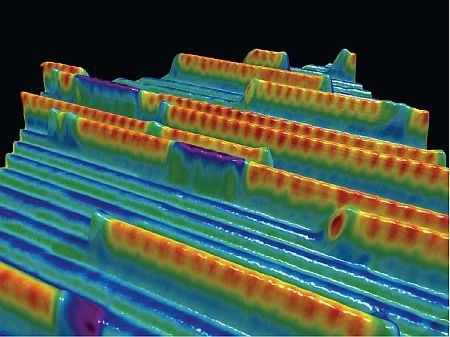Spin Spirals for Computers of the Future
Researchers from Jülich, Hamburg and Kiel propose new approach for nanoscale information transport
Advertisement
How can computer data be reliably stored and read out in future when computers are getting smaller and smaller? Scientists from Jülich, Hamburg and Kiel propose to make use of magnetic moments in chains of iron atoms. This would allow information to be transported on the nanoscale in a fast and energy-efficient manner over a wide temperature range, while remaining largely unaffected by external magnetic fields. The researchers have demonstrated this in both theory and experiment. Their work could pave the way for further miniaturization in information processing.

Magnetic order of chains comprising iron atoms (yellow/red) on an iridium surface (blue/green) recorded by a scanning tunnelling microscope with a magnetic tip. The image shows a sample section measuring approx. 30 times 30 nanometres. This technology combined with computer simulations allowed researchers from Jülich, Hamburg and Kiel to demonstrate that the magnetic order can be selectively modulated and used to transport information.
Universität Hamburg/Universität Kiel/Forschungszentrum Jülich
Up to now, computers have saved data in magnetic domains (“bits”) on the hard drive. These domains are already inconceivably small by human standards: a single 1 terabyte hard drive contains around eight billion bits. However, in order to make new functionalities possible, computer components will have to “shrink” even more in future. However, when the bits lie too close together, their magnetic fields overlap, making the writing and reading of data impossible. For this reason, new concepts are required. One method of transporting data on a nanometre scale was suggested recently by scientists at Forschungszentrum Jülich and the universities of Hamburg and Kiel.
“To the best of our knowledge, it is a completely new concept for data transport on this scale,” says Jülich physicist Prof. Stefan Blügel, director at the Institute of Advanced Simulation and the Peter Grünberg Institute. “Because the system is extremely stable and allows information to be transferred in a fast and energy-efficient manner, we believe it is an extremely promising option for future applications.”
“Spin spirals” is what the researchers call the spiral arrangement of the magnetic properties (spins) in chains of iron atoms, which they placed in twin rows on an iridium surface for their experiments. This is the first time that researchers have observed such an order in an atomic chain atom for atom. “Imagine that a spin spiral is like a screw,” says Prof. Yuriy Mokrousov from the Jülich Institute of Advanced Simulation. “If you hold the screw by its head and turn it, this rotation continues right to the very tip. This means that you can work out the position of the screw head if you know the position of the tip.”
How spin spirals will transport data in future can be explained using a highly simplified comparison: if you connect it at one end to a magnetized object, then its magnetic orientation can be read out at the other end, a few atoms and up to three hundred thousands of a millimetre (30 nanometres) further away. This would make it possible to compress data even further and then read them out via spin spirals. “What is particularly interesting,” says Prof. Blügel, “is the fact that the spin of the atomic screw, which we refer to as chirality in the jargon, is very stable – even at relatively warm temperatures.” The researchers have tested the system for temperatures of up to 100 Kelvin.
Physically, the spin spirals have a complex magnetic order – experts say they are “non-collinear” because the spins of neighbouring atoms are not parallel as is the case in simple magnetic materials. The complex order has advantages for certain applications. For example, from the outside they appear to possess only a small residual magnetization, which is why the entities are not sensitive to external magnetic fields. At the same time, however, they can be influenced to a small extent by magnetic objects at the ends, which is important for an efficient transport of information.
The samples were fabricated and investigated in Hamburg. The researchers used a scanning tunnelling microscope with a magnetic tip to measure the magnetic structure of the sample surface. In Jülich, highly complex computer simulations were performed to analyse the measurement data and to understand why the spin spirals form in the first place. The researchers now plan to investigate whether the system is also stable at higher temperatures of up to room temperature.




























































